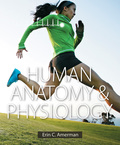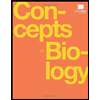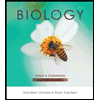
EBK HUMAN ANATOMY & PHYSIOLOGY
16th Edition
ISBN: 8220100659836
Author: AMERMAN
Publisher: PEARSON
expand_more
expand_more
format_list_bulleted
Question
Chapter 2, Problem 3AYK
Summary Introduction
To review:
Blocking of an enzyme by drugs and poisons can lead to cell death.
Introduction:
Enzymes are the biocatalysts. They are made up of proteins, the polypeptide chains of which are arranged in a definite three-dimensional structure, to catalyze a biochemical reaction. The enzyme has multiple sites to bind with the substrate. When a substance other than the substrate binds to the enzyme at the substrate binding site or at any other site, the activity of the enzyme gets inhibited. Such substances are known as inhibitors.
Expert Solution & Answer
Want to see the full answer?
Check out a sample textbook solution
Students have asked these similar questions
This practice question is from the textbook "Genetics: From Genes to Genomes". It is chapter 13, question 9.
a. Which two of the breakpoints could yield a deletion?
b. Write the sequence and polarity of a 16-base primer that, in conjunction with primer A, will allow you to diagnose the presence of a deletion in a patient’s genomic DNA. The evidence should be positive, not negative. (That is, you will see a PCR product whose presence and/or size is specific to the deletion; the absence of a band is not informative.)
c. Which two of the breakpoints could yield an inversion?
d. Write the sequence and polarity of a 16-base primer that, in conjunction with primer A, will allow you to diagnose the presence of an inversion in a patient’s genomic DNA. Your answer should show the primer that would yield the longest possible diagnostic PCR product. Your primer cannot cross any of the red lines.
e. Which two of the breakpoints could yield a reciprocal translocation? (Two possible answers exist;…
MyoD is a transcriptional factor that acts specifically in muscle cells. It is hypothesized that Id proteins indirectly repress the transcription of muscle-specific proteins by inhibiting the function of MyoD. Which of the following are mechanisms by which Id proteins act as indirect repressors? (choose all that applies)
Compete with activators for access to an enhancer.
Bind the activation domain of an activator bound to an enhancer.
Bind to activators and hold them in the cytoplasm.
Form heterodimers with activators and lessen the homodimers of activators.
Please explain each answer choice please.
Week 4 Rodney Balbo's Imaging service
Chapter 2 Solutions
EBK HUMAN ANATOMY & PHYSIOLOGY
Ch. 2.1 - Prob. 1QCCh. 2.1 - What are atoms?Ch. 2.1 - How do the three types of subatomic particles...Ch. 2.1 - What is an element?Ch. 2.1 - 4. How are elements arranged in the periodic...Ch. 2.1 - What are isotopes?Ch. 2.1 - Prob. 1AWYLCh. 2.1 - The element lithium has an atomic number of 3 and...Ch. 2.2 - What is a mixture?Ch. 2.2 - 2. How do the three types of mixtures differ?
Ch. 2.2 - Prob. 3QCCh. 2.2 - What is an ionic bond?Ch. 2.2 - 5. How is an ionic bond formed?
Ch. 2.2 - 6. Explain how polar and nonpolar covalent bonds...Ch. 2.2 - What are hydrogen bonds? Why do hydrogen bonds...Ch. 2.2 - Which would be more reactive-an atom of fluorine...Ch. 2.2 - Would a molecule of hydrogen (H2) form hydrogen...Ch. 2.2 - Explain why the molecule Na2 does not exist in...Ch. 2.3 - Prob. 1QCCh. 2.3 - Prob. 2QCCh. 2.3 - How do endergonic and exergonic reactions differ?Ch. 2.3 - Prob. 4QCCh. 2.3 - What factors can influence the rate of a chemical...Ch. 2.3 - 6. What is an enzyme, and what does an enzyme do?
Ch. 2.3 - Prob. 1AWYLCh. 2.3 - Explain why most biological molecules are stable...Ch. 2.3 - 3. Many naturally occurring poisons function by...Ch. 2.4 - What are four properties of water that make it a...Ch. 2.4 - 2. Which molecules are likely to be hydrophilic?...Ch. 2.4 - 3. Define the terms acid and base.
Ch. 2.4 - What is the pH scale? Which pH values are...Ch. 2.4 - What is the effect of a buffer on a solution?Ch. 2.4 - What is a salt?Ch. 2.4 - 7. What does an electrolyte do in a solution?
Ch. 2.4 - Explain how the water surrounding a fetus in the...Ch. 2.4 - Prob. 2AWYLCh. 2.5 - 1. How do polymers and monomers differ?
Ch. 2.5 - 2.3. How do monosaccharides, disaccharides, and...Ch. 2.5 - 2. How do monosaccharides, disaccharides, and...Ch. 2.5 - How are two monosaccharides linked to form a...Ch. 2.5 - Prob. 5QCCh. 2.5 - 5. How do phospholipids and triglycerides differ?
Ch. 2.5 - What are steroids?Ch. 2.5 - Prob. 8QCCh. 2.5 - How are amino acids linked to form peptides and...Ch. 2.5 - What are the four levels of structural...Ch. 2.5 - 10. What are the components and roles of ATP?
Ch. 2.5 - 11. How do DNA and RNA differ?
Ch. 2.5 - 11. What are the three components of a...Ch. 2.5 - Which molecule would be the most soluble in water:...Ch. 2.5 - In Module 2.3, you learned that increasing...Ch. 2.5 - 3. How could a defect in a gene lead to a...Ch. 2 - Prob. 1CYRCh. 2 - Fill in the blanks: Isotopes are atoms with the...Ch. 2 - 3. Which of the following statements correctly...Ch. 2 - 4. Explain the difference between an ionic and a...Ch. 2 - Identify each of the following molecules or...Ch. 2 - What are hydrogen bonds, and how do they form?Ch. 2 - Prob. 7CYRCh. 2 - Prob. 8CYRCh. 2 - Which of the following would not result in an...Ch. 2 - 10. An enzyme is a:
a. biological catalyst that...Ch. 2 - Prob. 11CYRCh. 2 - With respect to their solubility in water,...Ch. 2 - Mark the following statements as true or false. If...Ch. 2 - A salt is: a. a metal cation bonded to a nonmetal...Ch. 2 - 15. Compare and contrast the structures of...Ch. 2 - 16. Mark the following statements as true or...Ch. 2 - 17. Why is it important for a protein to maintain...Ch. 2 - Which of the following is not part of a...Ch. 2 - 19. Mark the following properties as belonging to...Ch. 2 - Which of the following statements is/are true...Ch. 2 - 1. In certain types of radioactive decay, the...Ch. 2 - Considering that water is a main component of the...Ch. 2 - 3. Explain why monosaccharides are polar and fatty...Ch. 2 - 1. The polysaccharide cellulose is not digestible...Ch. 2 - Some claim that the pH of your blood can be...Ch. 2 - Prob. 3AYKCh. 2 - Prob. 5AYKCh. 2 - You have just dropped some phospholipids into...
Knowledge Booster
Similar questions
- "Which of the following about transposable elements (TEs) is false?" RNA transposons move using an RNA intermediate. DNA transposons make up 3% of the human genome but are disruptive. Genes can move within the same chromosome via TEs. The Drosophila P element can only move in germline cells. Can you explain each answer choices pleae?arrow_forwardWhat will control the rate of bioremediation of petroleum? (Choose all correct answers) The availability of the petroleum The temperature of the water The availability of oxygen The percent of the population that has degraded petroleum in the pastarrow_forwardWhich of the following would lead to a false negative result in a sandwich ELISA (the lab manual refers to this as a direct ELISA- also known as search for antigen)? Mark all correct answers. antibody was non-specific and bound to something other than the antigen of interest. too short of a duration when incubating the reagents in the plate. If there are multiple strains of the pathogen of interest and the antibody does not recognize one of the strains. Did not sample the correct bodily fluid/area to detect the antigen concentration of antigen was too low to detect in the patient sample. inadequate washing was performed after the enzyme linked antibody was allowed to bind. substrate was exposed to too much light reusing a pipette that was used to pipette a positive sample.arrow_forward
- S. +1269 pts /1500 © Macmillan Learning 0 Resources Solution Penalized Feedback Try Again Draw the final product with stereochemistry and lone pairs. The leaving group has been pre-drawn for your convenience. +100 +100 : 0: + H,C- :0: : 0 0 : +100 +94 possible ✓ +100 K Attemparrow_forward+1269 pts /1500 © Macmillan Learning t/1188d950-dd73-11e0-9572-0800200c9a66/3045511b-267e-4a00-86ca-85dbc62ecb4e/6ac3a0c9-... a □ 出 All Bookmarks Due: Mon, May 26 Resources Solution Penalized Feedback Try Again KX Attempt 3 Draw the final product with stereochemistry and lone pairs. The leaving group has been pre-drawn for your convenience. :0: + нс H,C- :0: : 0:arrow_forwards. +1169 pts /1500 © Macmillan Learning 0 Resources Hint Submit Answer Step 3: This tertiary carbocation intermediate readily undergoes elimination with any weak base to form two possible products. + + H :0: H +94 possible 3a) Draw the minor organic product of elimination. Select Draw Templates More +100 +95 possible # C Major product + Minor product 3b) Draw the major organic product of elimination. Erase Select Draw Templates More C Erasearrow_forward
- Explain the Science & Society on (with links and pictures): ---- Question down below Discuss the ethical, medical, and societal implications of using advanced genetic techniques?arrow_forwardExplain the Disease Mechanism & Impact on (with links and pictures): What causes Leigh Syndrome and why it's so deadly. Which cellular functions, organelles (especially mitochondria), and macromolecules are involved.arrow_forwardExplain the Disease Mechanism & Impact on (with links and pictures): What's going wrong inside the cell and the effects on the human body. Describe metabolism with an emphasis on cellular respiration.arrow_forward
- Explain the Disease Mechanism & Impact on (with links and pictures):arrow_forwardExplain the Science & Society on (with links and pictures): Discuss the ethical, medical, and societal implications of using advanced genetic techniques.arrow_forward↑ LED Tt O Tt e 0 ✓ B > FLORES DIology Second Semester Review 7. Chi Square Analysis: wild dumpy male x ebony wild female F1: All wild wild F2: 142 wild wild males 52 wild ebony males 46 dumpy wild males 17 dumpy ebony males 151 wild wild females 47 wild ebony females 51 dumpy wild females 8 dumpy ebony females What pattern of inheritance is observed for body color? Autosomal recessive Autosomal dominant Sex-linked recessive Sex-linked dominant What are the genotypes of the parents in the P generation? a. XBYdd x XbXbDD b. Bbdd x bbDd c. BBdd x bbDD d. BBX Y x bbXDY How many flies in the F2 generation would you expect to express the dumpy wild phenotype? a. 289.125 b. 97 c. 96.375 d. 293arrow_forward
arrow_back_ios
SEE MORE QUESTIONS
arrow_forward_ios
Recommended textbooks for you
 Human Heredity: Principles and Issues (MindTap Co...BiologyISBN:9781305251052Author:Michael CummingsPublisher:Cengage Learning
Human Heredity: Principles and Issues (MindTap Co...BiologyISBN:9781305251052Author:Michael CummingsPublisher:Cengage Learning Concepts of BiologyBiologyISBN:9781938168116Author:Samantha Fowler, Rebecca Roush, James WisePublisher:OpenStax College
Concepts of BiologyBiologyISBN:9781938168116Author:Samantha Fowler, Rebecca Roush, James WisePublisher:OpenStax College Biology Today and Tomorrow without Physiology (Mi...BiologyISBN:9781305117396Author:Cecie Starr, Christine Evers, Lisa StarrPublisher:Cengage Learning
Biology Today and Tomorrow without Physiology (Mi...BiologyISBN:9781305117396Author:Cecie Starr, Christine Evers, Lisa StarrPublisher:Cengage Learning Principles Of Radiographic Imaging: An Art And A ...Health & NutritionISBN:9781337711067Author:Richard R. Carlton, Arlene M. Adler, Vesna BalacPublisher:Cengage Learning
Principles Of Radiographic Imaging: An Art And A ...Health & NutritionISBN:9781337711067Author:Richard R. Carlton, Arlene M. Adler, Vesna BalacPublisher:Cengage Learning



Human Heredity: Principles and Issues (MindTap Co...
Biology
ISBN:9781305251052
Author:Michael Cummings
Publisher:Cengage Learning

Concepts of Biology
Biology
ISBN:9781938168116
Author:Samantha Fowler, Rebecca Roush, James Wise
Publisher:OpenStax College

Biology Today and Tomorrow without Physiology (Mi...
Biology
ISBN:9781305117396
Author:Cecie Starr, Christine Evers, Lisa Starr
Publisher:Cengage Learning

Principles Of Radiographic Imaging: An Art And A ...
Health & Nutrition
ISBN:9781337711067
Author:Richard R. Carlton, Arlene M. Adler, Vesna Balac
Publisher:Cengage Learning